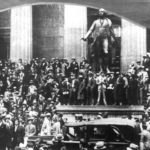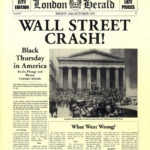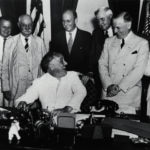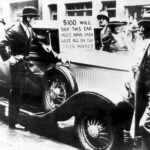History of investment banking (part 1)
The history of banking is a story that must be told in stages. It starts with its birth after the 1929 Wall Street Crash with the Glass-Steagall Law, and continues to present day with the Dodd-Frank Law Barack Obama signed after the 2008 financial crisis.

Currently, the main difference between retail banking and investment banking is that the former focuses on retail customers and their income primarily comes from interest and commissions from the loans they grant. Meanwhile, investment banking focuses on financing the development of large corporations.
But it hasn’t always been that way. These two branches of banking have evolved over time, demonstrating Wall Street’s ability to reinvent itself.

Wall Street trading floor in the 1930s.
The Great Depression: the starting gun of investment banking
The banking industry had been enjoying an excellent period of economic bonanza since 1924. At the time, it was thought that the growth would never stop. It was common for banks to grant loans to anyone with no collateral provided they use the loan to purchase shares. They were considered a safe investment. But all this prosperity came to an end.
In the summer of 1929, General Motors Director John Raskob wrote an article where he affirmed: “All citizens should be rich. If you invest $15 now you will earn $80,000 in 20 years.” Thursday, October 24, 1929 the Wall Street Crash occurred. More than 16 million shares plummeted, with no one to buy them. This left thousands of investors bankrupt.
Panic followed, leading thousands of people to try to withdraw their money from their bank accounts. Banks found themselves inundated by irrecoverable debts. Consumer spending screeched to a halt in the country. The U.S. stock market fell 80% and 600 banks collapsed. It was the start of the Great Depression.

London Herald front page.
Reforms begin
It was in this context that Franklin D. Roosevelt was proclaimed President of the U.S. in 1932. One of his first actions was to establish an interventionist program called the New Deal. It included a series of bank reforms that aimed to prevent this type of events from reoccurring. The most important part was the enactment of the Glass-Steagall Law which called for the complete separation of deposit banking and investment banking in Article 20.
Roosevelt’s main goal was to rebuild the nation’s confidence in the banking system and to get credit to flow again. With this goal in mind, the day after taking office, he forced the banking industry, including the Federal Reserve, to take a four day “vacation” while he worked on the Banking Act.

Franklin D. Roosvelt signing the Banking Act.
The Banking Act was legislated so quickly that some members of Congress did not even have a chance to read it before they had to vote. This law prevented customers’ deposits from being used for stock market speculation. From this point on, retail banks could no longer perform stock market transactions and investment banks could not accept deposits from their customers.
This law also regulated the operations retail banks’ could perform. For example, it set a limit for deposit profitability to prevent excessive competition among banks that could lead some to offer deposit that were too risky for them.
So, in order to protect the deposits of small savers, investment banking was born, separate from retail banking, which would now focus on its original purpose.

New York, 10/25/1929.- After black tuesday, a car is offered for net cash, as his owner lost all his capital in the stock market. - EFE
Renewal of the financial system’s pillars
Investment banking does not have an extensive network of bank branches. Instead there are large offices in the downtown area of big financial cities where investment banks work on designing and executing companies’ IPOs, mergers and acquisitions, bond issuances, trading operations, etc.
There was a set path for the financial sector. However, investment banking grew to such an extent that this path became too small. Instead, they started to need huge highways. Mergers would lead to the creation of the financial giants of the 21st Century. These institutions would later succumb to a financial crisis that dismantled the investment banking industry, as will be reported later.